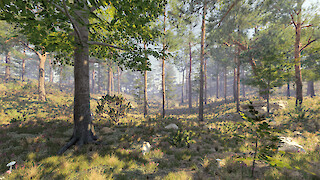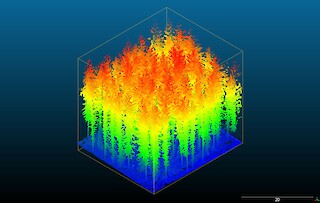We are in the forest, surrounded by trees, and the canopy barely lets any light fall on the floor. Now we travel through time into future, 100 years have passed. The forest has become less dense, warming rays of sunshine land on our faces and all around us there is cheerful humming and buzzing. What has happened? Forestry interventions, such as the thinning of the tree canopy, have turned the formerly thick forest into a lighter and more diverse ecosystem. This is beneficial for light and warmth loving animals and plants which need a sparser tree cover to thrive. Favouring more climate-resistant species such as the Scots pine makes forests more resilient against draught and rising temperatures. In my VR experience, visitors embark on a journey through time. They initially explore today’s dense forest and can then visit the same forest 100 years later. Several information points illustrate the different processes connected with forestry interventions, enabling the interested audience to see the benefits and disadvantages that come with forest thinning.
Developed in close cooperation with the research group VR Forest at ETH Zurich, this project explains the necessity of forestry interventions to prepare forests for the hot and dry climate of the future. The immersive experience in a virtual future forest conveys information, encourages reflection and thus promotes public acceptance of sometimes drastic interventions in forests as recreation spaces. Displaying a strong sense for design decisions, Michelle Weber has created a complete VR application that is appealing in terms of visuals and audio and aesthetically convincing. It contains six information points and provides great opportunities for practical use and research. The protect demonstrates the high potential of visualising research findings and climate-based future scenarios in VR and is expected to be pursued further by the research group of the subject area Knowledge Visualization in collaboration with the ETH. – Excerpt from the supporting statement of the Subject Area Knowledge Visualization

«My dissertation project highlights the potential of visualising research results and climate-driven future scenarios in VR.» – Michelle Sarah Weber

«In future, I see myself working in the field of visual transfer of knowledge, at the interface between design and science.» – Michelle Sarah Weber
